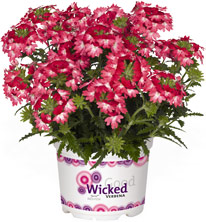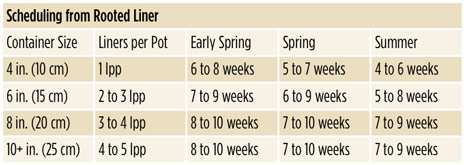10/29/2014
Growing Wicked Verbena
Emily Mason

RED FOX introduces four new cultivars to its innovative Wicked Verbena series of 3-D garden color. Upgrade your verbena assortment by adding Wicked Mad Magenta, Wicked Cool Blue, Wicked Great Grape and Wicked Pink Pepper Improved to your spring program. Consumers will be drawn to these never-before-seen novelty color patterns in the garden center.
Other colors include:
- Wicked Mad Magenta: combines swirls of magenta, purple and white into one massive blossom
- Wicked Cool Blue: replaces Wicked Blue with darker, more vivid blue petals that are sharply contrasted against crisp white
- Wicked Great Grape: showcases a deep pop of purple, coupled with lavender and white
- Wicked Pink Pepper Improved: flaunts vivid coral with a kiss of bright pink on its eye-catching blooms.
And if it’s dynamic combos you’re after, Wicked Verbena is a devilishly good addition to Confetti Gardens. Find it in our Confetti Trio Series: Shocking Blue, Shocking Pink and Shocking Purple.
Wicked Verbena has a compact, mounding habit and is suitable for quarts, gallons, hanging baskets and combinations planters. It’s available as rooted and unrooted cuttings from RED FOX Rooting Stations.
Sticking and rooting culture
Open boxes as soon as cuttings are received. Cuttings may be stored overnight at 45 to 50F (7 to 10C). Always use a disease-free rooting medium that’s well aerated, with pH 5.8 to 6.2 and EC less than 1.5. Ensure that all surfaces the cuttings contact are sterile. A rooting hormone isn’t needed.
After sticking, water the cuttings uniformly for good “rooting medium-to-cutting” contact. Day and night temperatures should be maintained between 65 and 75F (18 and 24C). To enhance and promote uniform root development, apply bottom heat at 72 to 75F (22 to 24C). Mist for 4 to 6 days, or until cuttings become rooted; excessive misting can result in disease and leaching of nutrients. Maintain light levels at 1,000 to 2,000 f.c. (10,500 to 21,500 lux) during rooting.
After cuttings have established roots, increase light levels to 2,500 to 4,500 f.c. (27,000 to 48,500 lux), and fertilize with a 100 ppm N solution from a complete fertilizer. B-Nine or Dazide (daminozide) at 2,500 ppm may be applied to control stretch, beginning one week after sticking. Avoid excessive watering, low light and low temperatures to promote healthy, compact plants.
Transplanting
Use a disease-free, well-aerated growing medium, with a pH of 5.8 to 6.2 and an initial nutrient charge. Use only new, sterile growing medium and containers. Before transplanting, water rooted cuttings well and moisten finished container medium.
Finishing
Once liner has rooted into finished medium, apply liquid feed of 200 to 300 ppm N from a complete fertilizer. Excess ammonium-containing fertilizer may cause soft growth and internodal stretch. Verbena is sensitive to both drying out and being too wet, so be sure to manage water and humidity to reduce occurrence of diseases like Botrytis (gray mold). Powdery mildew is best prevented by maintaining dry leaves and a lower humidity. Air movement, preventative sprays and early detection by means of an excellent scouting program will best prevent powdery mildew.
Leach regularly to maintain an EC of 1.5 to 2.0, and maintain a pH between 5.8 and 6.3. Grow at 65 to 75F (18 to 24C) during the day and 60 to 65F (16 to 18C) at night with good air circulation. Verbena responds well to negative DIF. Temperatures that are too low may cause leaf necrosis. Maintain light levels at 5,000 to 6,000 f.c. (53,500 to 64,500 lux).
Once plant roots reach the edge of the container, a hard pinch (above the fourth or fifth set of leaves) will promote branching. Florel (ethephon) at 300 to 500 ppm, applied two weeks after transplant, will promote branching and can replace pinching. Additional applications can be made, but may delay flowering. B-Nine or Dazide (daminozide) at 2,500 ppm may be used to reduce plant stretch.
GT

Emily Mason is Red Fox Brand Manager for Dümmen Group.